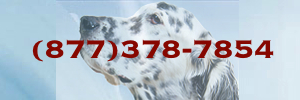Help! My Dog's Mouth Smells Bad!
Why Does my Puppy’s Breath Smell so Bad?
Romeo was a 10-month-old Brindle Chihuahua with halitosis (hal -i -toe- sis). That’s doctor-speak for bad breath.
“Doctor, why does my 10-month-old Chihuahua have such bad breath?” said Romeo’s dad.
One look under his lip revealed the answer.
“Romeo’s maxillary deciduous canine tooth is retained,” thought Doc Truli.
“Romeo’s left upper baby canine tooth didn’t fall out on time,” said Doc Truli.
Romeo had two other retained canine teeth and a retained upper incisor front tooth as well.
“Romeo needs surgery right away to remove the abnormal tooth before it causes further damage and infection in the mouth,” said Doc Truli.
FAQs About Retained Baby Teeth in Dogs
Questions Every Pet Parent Asks About Baby Teeth:
Q: Shouldn’t we give it more time to come out on its own?
A: No! The minute a baby tooth and a permanent tooth share the same space, when the permanent tooth just starts budding through the gingiva, the baby tooth is retained, by definition. The body usually dissolves and absorbs the roots of the deciduous (baby) teeth, and the tops, or crowns of the teeth naturally drop off. Retained teeth do not resorb, or only partly resorb, creating a crowded, crooked, disease-holding spot in the mouth.
Q: Can’t we wait? My puppy seems too young to undergo surgery.
A: No! Never underestimate the disease and pain-causing ability of abnormal teeth. Any risk of anesthesia, in most patients, is far outweighed by the health risk of doing nothing. If you do nothing, your puppy will have a problem.
Q: How long will it take to heal?
A: Deciduous tooth extraction sites heal phenomenally quickly. Textbooks say 14 days, but usually, you’d be challenged to find the hole in the gums within 3 days or so. For this same reason, unless a surgical approach is needed to remove a long, delicate tooth root, sutures are rarely needed for baby teeth removal.
Q: Do all dogs have this?
A: Any dog could have retained baby teeth. But, most puppies with retained teeth are small breed companion dogs.
Tru Tip: Top Dog Breeds for Retained Baby Teeth
- Chihuahua,
- Yorkie,
- Shih Tzu,
- Maltese,
- Poodle,
- Miniature Pinscher,
- Miniature Dachshund,
- Miniature Schnauzer,
- Whippet,
- Xolo,
- Powder Puffs,
- Papillon,
- Italian Greyhound,
- Lhasa Apso,
- Havanese,
- Coton de Tuleur,
- Bichon Frise, even
- French Bulldogs and other Bulldogs sometimes.
What Happens During Surgery to Remove Retained Baby Teeth?
Romeo underwent dental surgery under anesthesia that same afternoon.
Puppy Pre-Op
First, the puppy gets his physical examination, pre-operative testing, which may include laboratory blood work, EKG, or other tests your veterinarian feels necessary to assess anesthesia risks in your puppy.
Then, a sedative, anti-anxiety medication, and painkillers are given.
Dental Diagnostics and Monitoring Anesthesia
Once anesthesia is induced, dental radiographs are obtained (in 5-10% of veterinary hospitals in America. The others do not have the technology.) Monitoring equipment is hooked up. And the x-rays are taken.

The x-ray tube (blue arrow), digital plate (red arrow), and anesthesia machine (yellow arrow) surround Romeo
Can you find Romeo (upside-down) in the picture? The little guy is almost covered in diagnostic and monitoring equipment!
The doctor charts the teeth while the technician monitors anesthesia. Charting means examining 6 points around the base of each tooth and assessing the periodontal pockets (if any). Charting also means recording missing teeth, extra teeth, crowded, broken, tipped, dead (sickly grey color), or otherwise notable teeth.
The dental x-rays help to find impacted teeth that may not have erupted. You can imagine, if this Chihuahua did not drop baby teeth normally, well then, possibly some teeth have not even shown up at all! Even if the teeth are not impacted, crowding, root deformities, and missing teeth need x-rays to show them.
Finding the Problem
The retained tooth (pictured above) looks wavy and small and crooked on the x-ray. The gap between the deciduous tooth and the normal canine tooth in front of it (to the left) harbors fur, food, and soon-to-be tartar!
If this tooth is not taken care of and removed, the infection, fur, and food will impact into the gums and wear away at the space behind the permanent canine tooth. Most dogs will not show discomfort, even though logically, this has to be annoying at the least!
If left for years, the permanent canine will become loose and infection can travel up the long root right into the floor of the nose! If this happens, infection and pus might leak out one nostril, but usually not both. What a shame all that pain and suffering and disease could be stopped when the puppy is young and strong!
Read another story about masquerading retained baby teeth in a 3-Year-Old Maltese, with more information about painkiller drug interactions and steps to anesthesia recovery the night you take your baby home after the surgery!
After dentistry procedures, wait about 3-5 days, or until your veterinarian says it is safe, and then you can start brushing your dog’s teeth to prevent new problems.
from → Bichon Frise, Chihuahua, Coton de Tuleur, Dachshund, Daily Practice, Dog Medical Stories, Dogs, French Bulldog, Havanese, Italian Greyhound, Lhasa Apso, Maltese, Miniature Poodle, Miniature Schnauzer, Pet Dental Success Stories, Pet Health, Pet Medical Stories, Pet Stories, Pomeranian, Powder Puff, Shih Tzu, Whippet, Xolo, Yorkshire Terrier













Thanks nice article.